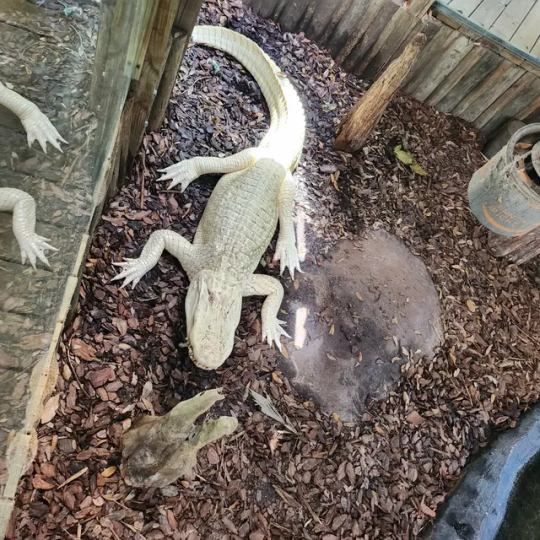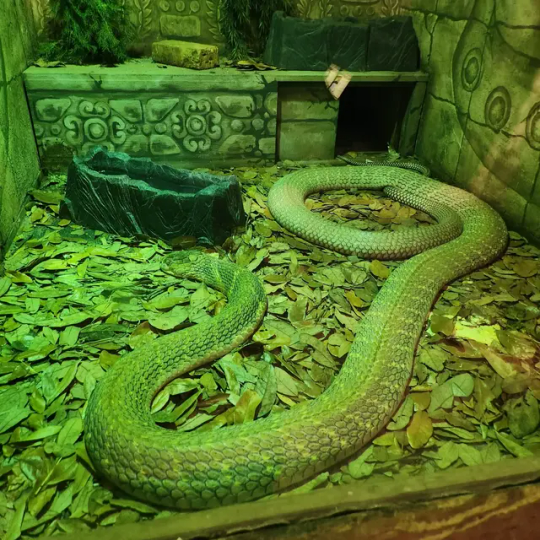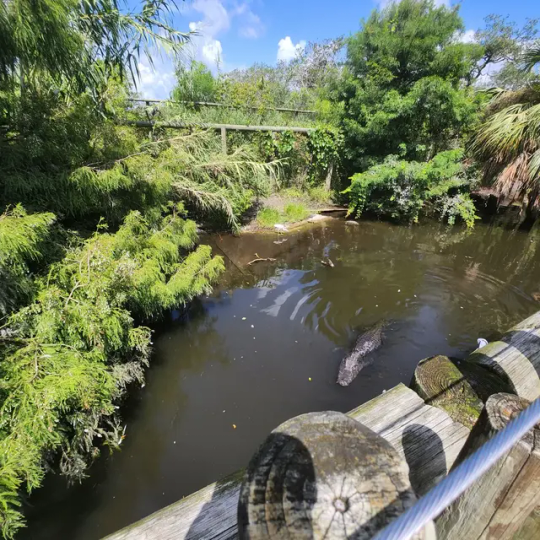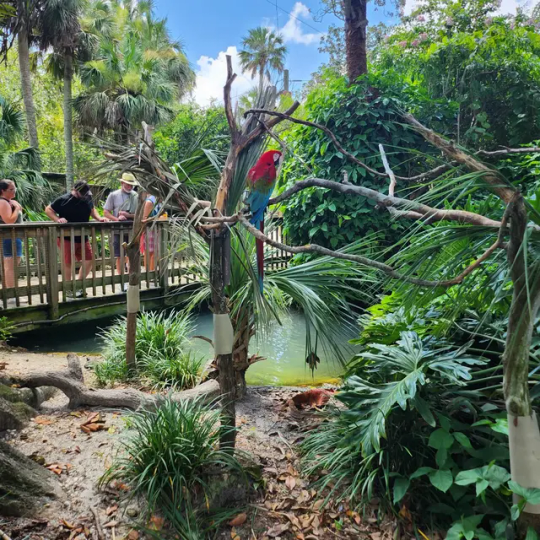#alligator farm
Explore tagged Tumblr posts
Text

Albino alligator
St. Augustine Alligator Farm, Florida
June 2024
#alligator#gator#alligator farm#st. augustine#florida#travel#original photography#photographers on tumblr#photography#lensblr#wandering#zoo#nature#nature photography#wildlife#wildlife photography#animals#animal photography#reptile#reptiblr#herpetology#wanderingjana
32 notes
·
View notes
Text

(I started making memes).
#Lsd#memes#aligator#ducks#funny stuff#funny memes#lol#haha#alligator farm#absurd#philosophy#like crazy#viral#reality#wisdom
5 notes
·
View notes
Text
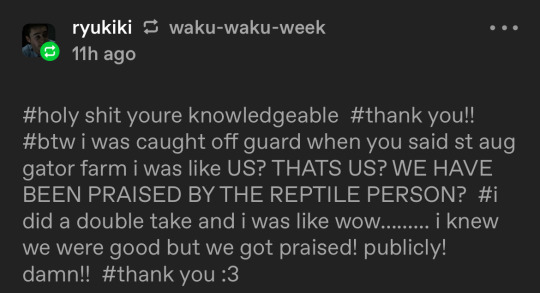
Aug ABSOLUTELY deserves the praise, @ryukikit. St. Augustine Alligator Farm is one of my favorite animal facilities, hands down. It's a pretty zoo, doable in an afternoon if you kinda like crocodilians, or an all day affair if you REALLY like crocodilians. Here are my favorite things about it and why I think it's worth supporting.
1. They keep animals in interesting social groups.

Crocodilians are heavily involved parents, but most places that breed them don't have the enclosure space to let the babies stay with the parents. St. Augustine does. One of my favorite groups was their crèche of slender-snouted crocodiles. They had the parents and then a yearling cohort and a new hatchling cohort. This aligns with how these guys live in the wild- the babies stick around longer! They have the space for it, and they are very in tune with the social needs of their animals.
Very, very few zoos can keep their baby crocs with the adults and still perform maintenance and animal health checks safely. This doesn't mean these facilities are bad- it just means that they have different management practices. And frankly, a lot of these species aren't frequently bred elsewhere. Your average zoo doesn't need a setup where you can have a multiyear crèche for slender-snouted crocodiles. Some species have better success when the young are pulled early, and some zoos are better set up to raise out any offspring separately or behind the scenes. Every facility's practices are different, and this just happens to work well at St. Augustine and be really enjoyable to see as a zoo patron.
Crocodilians are exceptional parents and very protective. It's a sign of incredible animal management practices and animals that feel very comfortable with staff that St. Augustine can do this with nearly every species they breed.
2. They understand the social needs of their animals.
Some crocodilians are social. Some are solitary. Some can live happily with a member of the opposite sex but get territorial around members of the same sex. St. Augustine pays incredible attention to their social groupings to ensure that they aren't just meeting the animals' physical health needs but their social needs as well. They do continuous scientific research about social structures in crocodilians, taking blood samples to test stress hormones and observing stress behaviors to see how group dynamics change.

For example, St. Augustine is home to one of the world's largest known living saltwater crocodiles, Maximo. And his comparatively tiny mate, Sydney. During the educational presentations with these two, they point out that even their monster of a croc needs his social group- he won't eat if she's not around and he is calmer during medical checks if he can see her. These animal share a deep and special pair bond, and they make sure to talk about how the social aspect of these animals' lives is integral to their care. It's a unique aspect of the way they talk about these animals, because he IS a spectacle and he IS a sensation, but they don't talk about him like he's a mindless killing machine- they talk about him like he's a big, complex predator with social needs like any other animal. Aug is the only facility I've been to where the emotional and social needs of crocodilians is part of the education they provide guests- and speaking of education...
3. Their demos and presentations are extremely good.
The presentations at St. Augustine are some of the best I've ever seen, and I've seen literally hundreds of animal talks on everything from aardvarks to zebras. But as you... can probably tell from my blog content, I've spent a lot of time learning about and working with reptiles. I really enjoyed all of their presentations because they are very scientific about things and avoid sensationalism. They really want you to be fascinated by these creatures and love them- but more than anything else, they want you to respect them.
Also, they do a really good job handling their ambassadors. I really enjoyed something as simple as watching an educator tell us about snakes. Throughout the whole presentation she made sure that most of the snake's body was looped in her hand. The snake was always supported and was very calm. She gave the snake plenty of head room so that it didn't feel constricted- it was just good handling all around.

But also, the presentations made it clear how much the park cares about the animals' well-being. When they do the feeding and training presentations, they make it very clear that the animals' participation is entirely voluntary. They do things differently for their 9-foot saltie and their 16-foot saltie, because the 16-footer is so large and heavy he actually struggles walking on land sometimes. They adapt their programs and his care to ensure that he's completely comfortable- and he didn't actually participate in the whole feeding when I was watching! At no point did they try to push him into anything uncomfortable; they offered, he didn't engage, and they moved on. It was a clear expression of his boundaries, and I really appreciated how much his caretakers respected that.
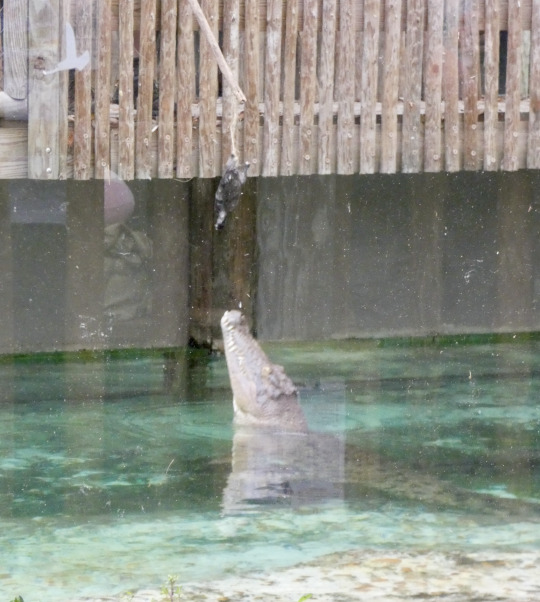
4. Ethical Interactions
I've been to... a lot of tourist locations in Florida that have animals you can hold. Almost always against my will! Many of them are pretty terrible, and you don't actually learn much, if anything. But I really found that to not be the case at St. Augustine. Every single animal presentation and interaction opportunity was accompanied by education about the animal's biology, habits, and- crucially- their conservation status.
When I held a baby alligator at St. Augustine, the proctors- there were two, one to ensure I was holding the gator correctly and the other to educate- were very informative about the role alligators play in their ecosystem and their conservation history. The animals were all properly banded, and one of the two proctors was there to ensure that none of the baby alligators were uncomfortable. As soon as they started getting squirmy or tense, they were removed, unbanded, and taken to an off-exhibit area to relax. And when the babies age out of petting size, they just go in the lagoon to live with others of their species. I saw one upset alligator the entire time I was there, and he was clearly upset that his escape attempt was foiled by a keeper during my nursery tour.
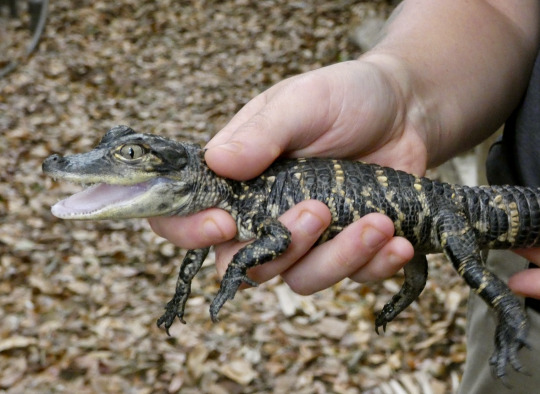
Even though he's restrained in this shot, you can see that his full body and tail are supported, and the grip, while firm, is gentle. He's distressed, but after I took this picture, she put him in his enclosure and he calmed down immediately.
Sometimes when you have petting attractions with baby animals, those animals... don't have a happy ending. (See: cub petting.) But St. Augustine's program is fine- the gators are all aged out of wanting to have mom around, there's no declawing/defanging, and they're handled with care. And it's worth it, because people love what they understand. St. Augustine was integral in raising public awareness about alligators back in the 60s when they were endangered, and now they're thriving- largely in part to programs like St. Augustine getting people to care.
And speaking of getting people to care, let's talk about their research.
5. Shared Research Results
St. Augustine is also home to more species of crocodilian than anywhere else in North America- all of them, usually. (They didn't have a Tomistoma when I visited- that may have changed.)
Because of this species diversity, it's an incredible research resource. Having every species means that you can do a lot of work comparing their behaviors, their growth patterns, and more. They've been a major research site for crocodilian biology since the 1970s. Today, they're one of the key sites for studying crocodilian play and social behaviors. They actually maintain a blog where they post copies of papers that were written using their animals, meaning that you can actually see the results of the research your admission helps fund. You can see that right here: https://www.alligatorfarm.com/conservation-research/research-blog/
All of this adds up to a zoo that provides a unique experience, tons of actual education, and transparency about what its research and conservation steps actually are. St. Augustine's come a long way since its opening in 1893, and they really do want you to leave with a new respect for the animals they care for. Ultimately, if you're a fan of reptiles, you can feel good about visiting the St. Augustine Alligator Farm- their care and keeping are top of the line, they do a ton of innovative conservation research and support for conservation organizations, and you can see this animal there:

(Gharial from the front. Nothing is wrong with her that's just what they look like from the front.)
6K notes
·
View notes
Text
LINK FEST: 18 JULY 2023
Links that may or may not be related to gardens, food, travel, nature, or heterotopias and liminal spaces but probably are. Sources in parentheses. images: Artist Spotlight: Cara Nahaul (Booooooom). I like the bright splashes of saturated colour and her “inspiration from her early childhood visits to Malaysia and Mauritius.” photo essay: Photographs of the Los Angeles Alligator Farm (ca. 1907)…

View On WordPress
#alligator farm#art#artwork#best bathroom contest#cintas#flower arranging#flowers#linkfest#links#paintings#photo essays
0 notes
Note
Hey, I'm about 40 mins west of St. Augustine... is the Alligator Farm worth seeing with my young adult kids? Thanks for any input you have:)
Absolutely huge yes! The Alligator farm is legitimately one of my favorite places to visit and I think anyone could enjoy a day there. It’s a little unique as a zoo because there is much more focus on reptiles and birds than on mammals (though they have mammals too!). If your kids have even a whisper of interest in crocodilians and birds they will be in total heaven. The AF rookery is probably the best place in Florida to see nesting spoonbills so a visit during the spring and early summer is a must if you have any bird enthusiasts in the mix.
I can also personally attest to the high quality of care provided to animals at this facility. I did some field work there in vet school and was constantly blown away by the individualized care for even their tiniest of critters. The Alligator Farm was also the first zoo in the United States to get a perfect score from the AZA- which is an amazing accomplishment! You can be confident that the animals you’re visiting are in really great hands, which means a lot.
If you get a chance to go I’d recommend catching one of the feedings with their saltie Maximo, he’s an amazing animal.


#asks#st augustine alligator farm#sorry to gush but this is my favorite zoo!#really lovely place with people who have devoted their lives to crocodilians
159 notes
·
View notes
Note
do all inkfish have tails in this au? or is it just certain species? <-(noticed samahs silly tail)
Not all inklings have tails, it’s considered an old fashioned trait, the cuttlefish family seems to have tails, but it’s considered a sort of symbolic idol thing to inklings, since they’re descendants of Craig Cuttlefish— it’s become a symbol of the success of the inklings and the ideas and styles of the current generation, in a strange, convoluted way. Callie and Marie style thier tails in fashions that resemble current (splatsville) inkling hairstyle trends.
It’s more common for inklings to be born tailless, and in fact it’s more fashionable, as tails are seen as barbaric— an animalistic trait, the squid sisters act as an exception because to Inklings its a BRAND , in streets you’d catch a few curious glances if you had a long tail. Maintaining “ human “ skin tones is ALSO fashionable, warm hues and appearing ALIVE is a beauty standard, since Inklings tend to run cold and they tend to run with green muddy “colder” hues. The reasons why this became popular seems to stem from a hatred towards Octarians, who more commonly have greenish colors, tails, prominent gills, claws, etc etc… and a design that directly counteracts Octarians are common, as they try and remove themself from their aquatic ancestors. (Inklings to me are actually a desert species, I might elaborate on this later haha.)
Most Octarians have tails, most clip them— more commonly parents or guardians of Octarian hatchlings (especially those from the domes) clip their tails after they begin to develop tails, not because of any fashion reasons … but solely because it’s more efficient. Most Octarians have docked nub tails…
Surface Octarians, and other Southern or Tidepool born Inkfish populations that are far removed from Splatsville inklings tend to exhibit more species specific traits.
#asks#homerun au#alligator is from a farming village far east… she has strong fins which aren’t a common trait.#octarians
25 notes
·
View notes
Text
lori loves alligators and i think she'd go to one of those farms to feed them. especially after a hard day
#the farm is probably questionable and run by locals. 0 tourists <3#or if theres tourists theyre definitely getting scammed#if you see her feeding 10 chickens to some alligators you know shes stressed. she says sorry to the chickens before she throws them#they’d be dead obviously but she still says sorry
5 notes
·
View notes
Text
does anyone. who has ever been to St Augistines Alligator Farm. have pictures of makara, the baby gharial who hatched in 2016. i am not lying when i say i will pay money to see pictures of these. please show me my girl.
6 notes
·
View notes
Text

Lil collab thing I did with someone who wishes to stay Anonymous :3
#muse arg#happy meat farms#don't feed the muse#dftm#conspiracy carl#ramona bynes#Carl + alligator v.s Ramona who will win 🤨🤨🤨#digital art
15 notes
·
View notes
Text

Brouwerij West Alligator IPA (Picked up at Windmill Farms). A 3 of 4. Lots of citrus and tropical fruit and a nice bit of citrus pith bitterness in the body. Medium body, well-balanced, and quite tasty.
6 notes
·
View notes
Text
Ok listen I have worked with alligators and this is absolutely 100% unnecessary force. A wooden pole and a light tap to the nose will absolutely do the same thing, and honestly running at them to slam a shovel on their face is Not Cool.
And truly, genuinely, if the comments are to believed and they are being herded to be safely fed, the same thing can be managed with a catwalk or an 8 foot tall tower to “protect staff” and these animals are definitely smart enough to figure out when and how food is delivered, so if it’s always dumped in the pool, hungry gators will always be in the pool at meal time.
#we can debate the ethics of alligator farming endlessly#but alligator farming is what saved alligators from extinction
19K notes
·
View notes
Text

Serj Tankian - Beethoven's C@nt
“Find the little, evil perpetrator And feed him to the hungry alligator”

“The arms of time are breaking off, Civilization is on trial”

“I’ve been walking through these dead farms I’ve been screaming through these dead lungs” https://youtu.be/-ZgcvTqUBj8
#ai art#serj tankian#beethoven#lyrics#quote#find#little#evil#perpetrator#feed#hungry#alligator#arms#time#breaking#civilization#trial#walking#dead#farms#screaming#lungs
0 notes
Text
*Basically anything that isn't a typical farm animal: cow, pig or sheep. Not including birds or fish- might include that in a different poll.
(Obligatory Note: I'm American and this is based on what's overall unconventional to eat in the USA.)
Edit: To clarify just in case, I meant to have "None of these" mean "I've never tried any four legged creature that wasn't cow, pig, or sheep".
Edit 2: I live in an agricultural area. It appears this may have skewed my view on how frequently anything else is eaten. We have the Store and the Farm and that's it.
16K notes
·
View notes
Text
They look so much like a bunch of Skeksis went to the bathroom together to fix their makeup and I love it so much.
Hands down my fave thing about hurricane season is when zoos put their birds in the bathroom to protect them from the wind and we get images like this

Photo from St Augustine Alligator Farm
91K notes
·
View notes
